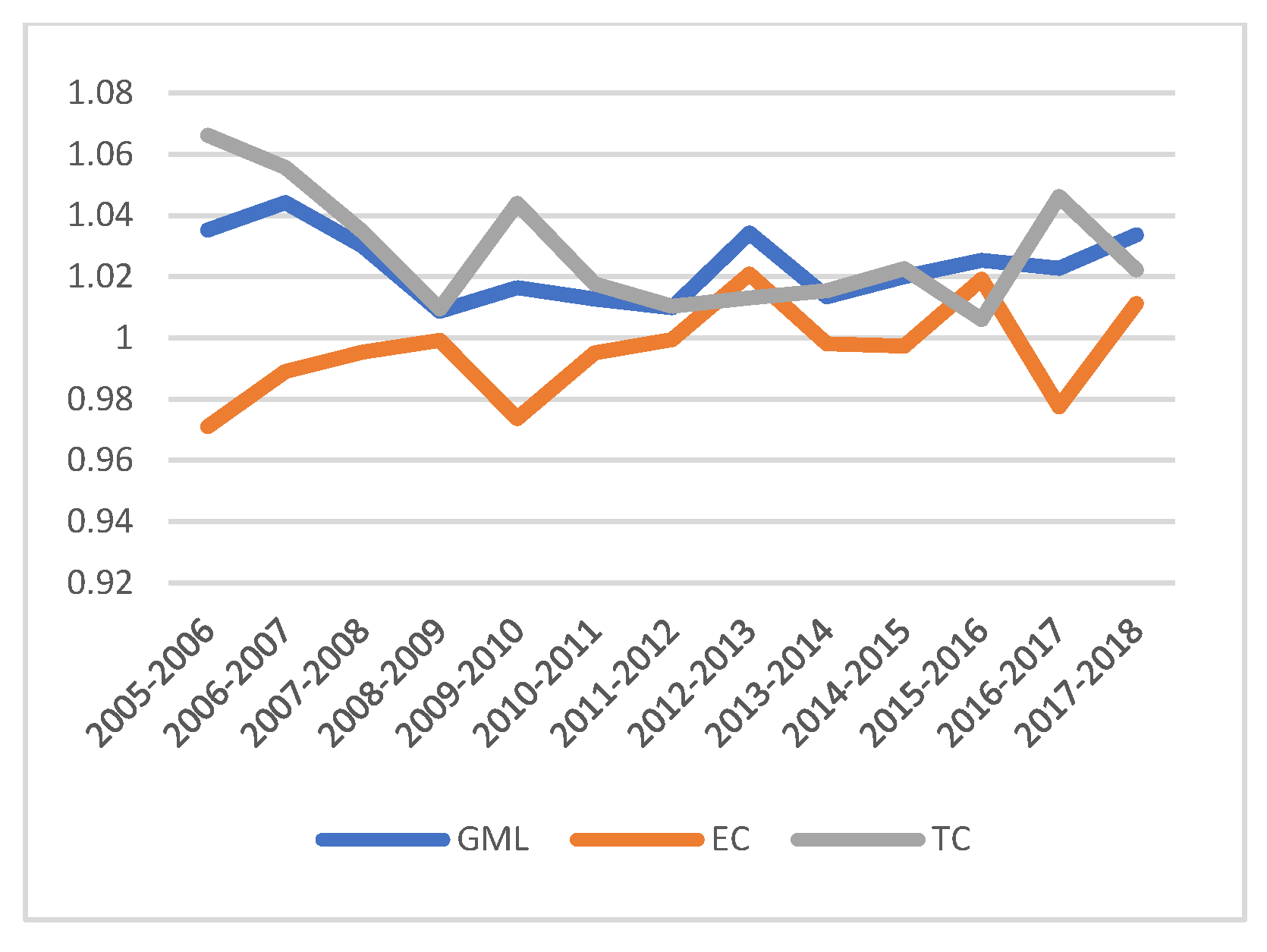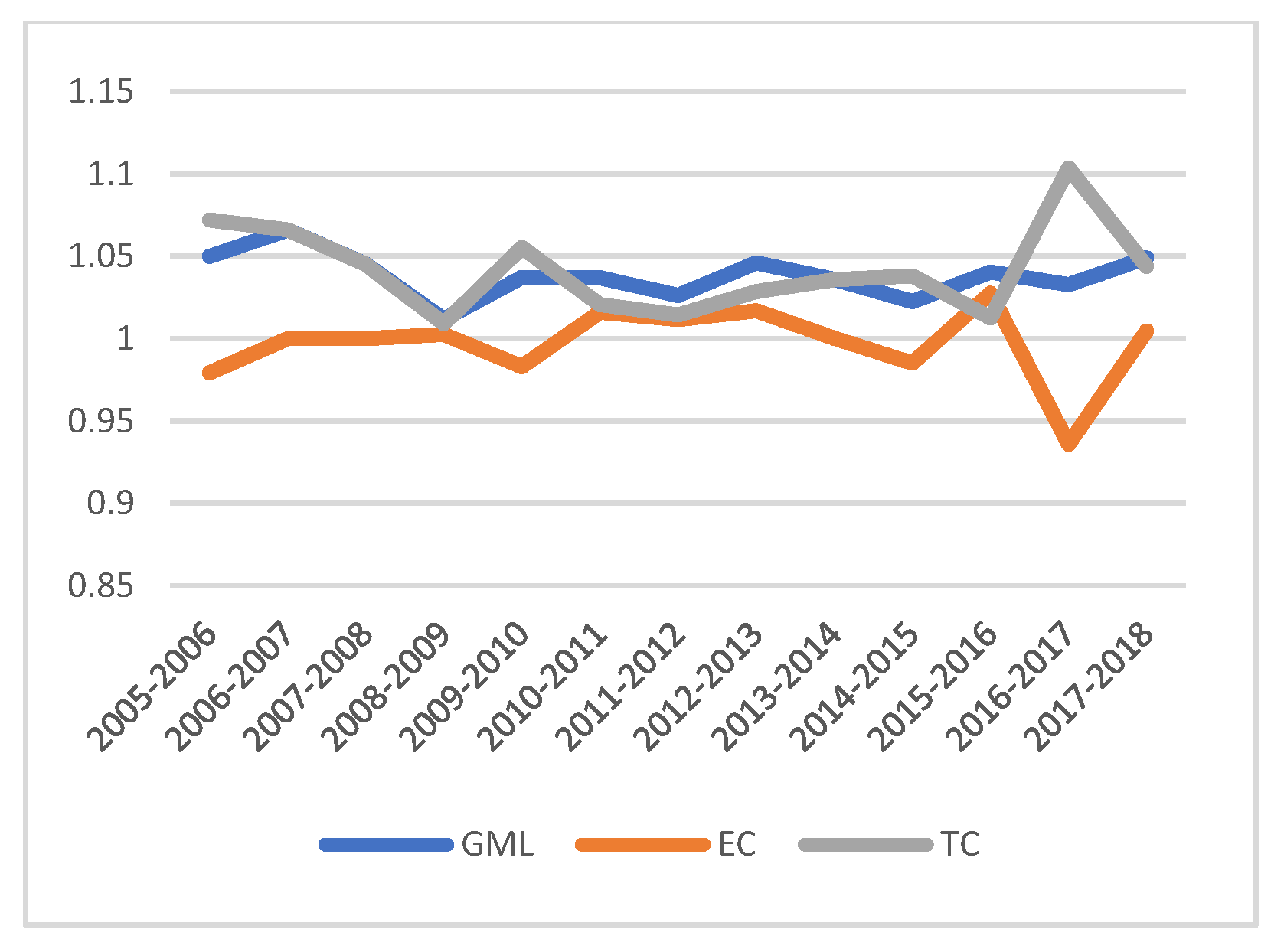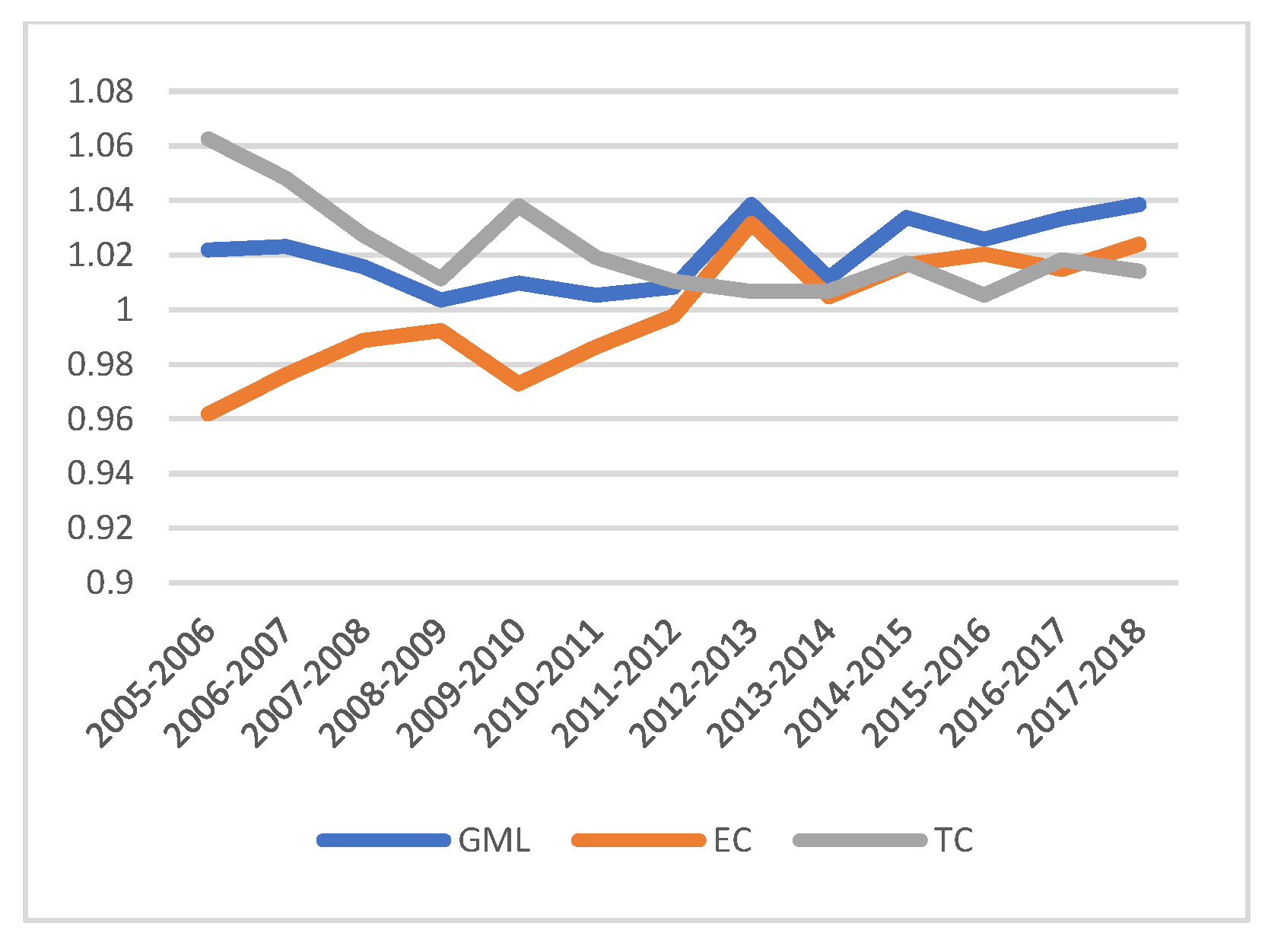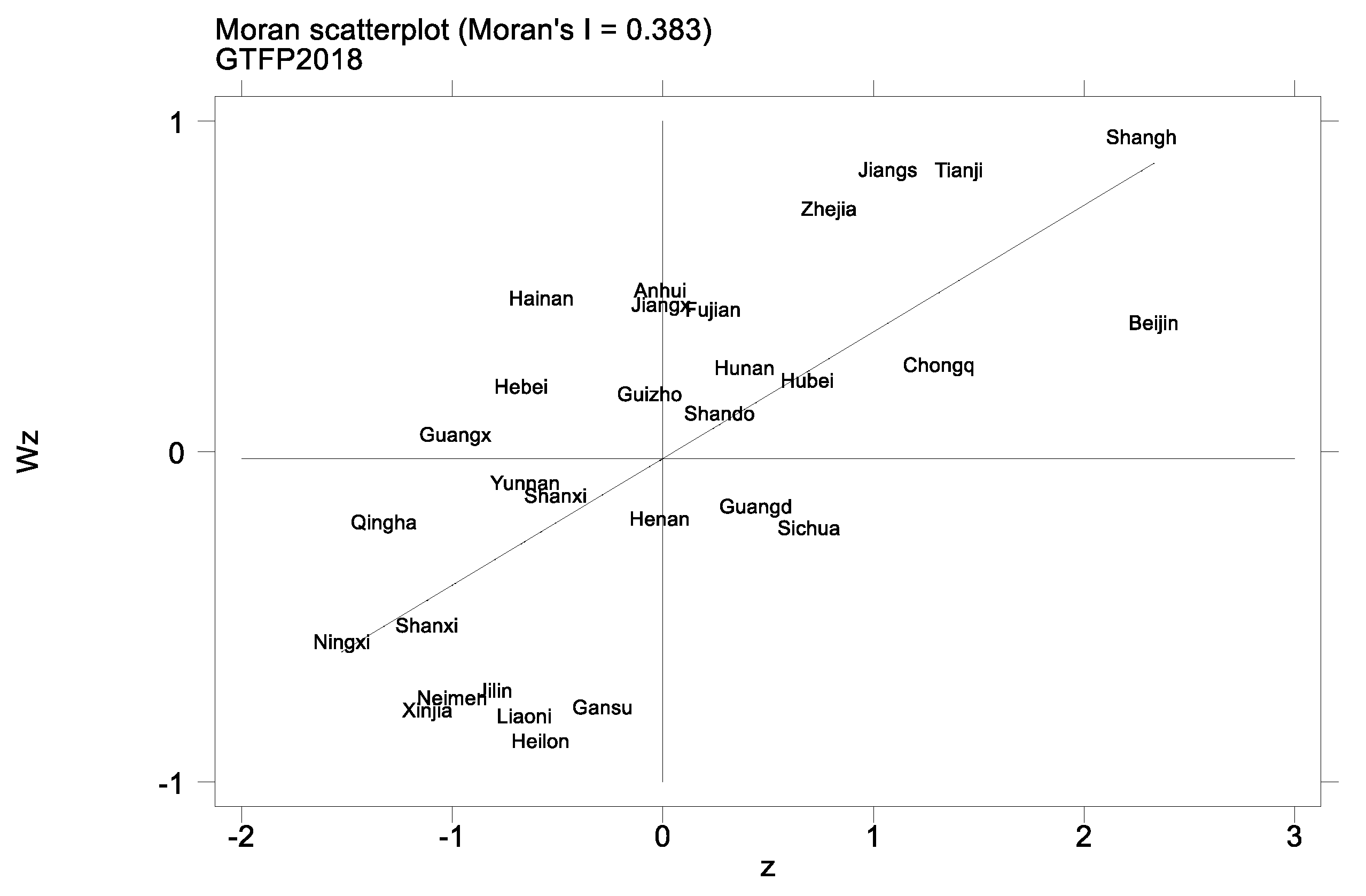Investigating the Spatial Spillover Effect of Transportation Infrastructure on Green Total Factor Productivity
Abstract
1. Introduction
2. Theoretical Background
3. Material and Methods
3.1. Selection and Description of the Variables
3.1.1. Dependent Variables
3.1.2. Explanatory Variables
3.1.3. Control Variables
3.1.4. Data Sources
3.2. Specifications of the Spatial Econometric Model
4. Results Analysis
4.1. Spatial Autocorrelation Test
4.2. Selection of the Spatial Econometric Model
4.3. Direct and Indirect Effects
4.4. Robustness Test
4.5. Regional Heterogeneity
4.6. Discussion
5. Conclusions and Implications
Author Contributions
Funding
Institutional Review Board Statement
Informed Consent Statement
Data Availability Statement
Conflicts of Interest
References
- Smith, A. The Essential Adam Smith; WW Norton & Company: New York, NY, USA, 1987. [Google Scholar]
- Guo, G.; Liu, R.; Huang, Z. Economic Growth Model of Transportation Infrastructure Affecting Consumption. Econ. Res. 2019, 54, 166–180. (In Chinese) [Google Scholar]
- Xun, Z.; Xu, W.; Guanghua, W.; Fangcheng, S. A Comprehensive Framework for Transportation Infrastructure to Promote Economic Growth. J. Econ. Res. 2018, 15, 5–23. [Google Scholar]
- Wang, L.; Zhai, B. Impact of transportation infrastructure on economic growth in the Yangtze River economic belt. Resour. Environ. Yangtze River Basin 2018, 27, 6–12. [Google Scholar]
- Celbis, M.G.; de Crombrugghe, D. Internet infrastructure and regional convergence: Evidence from Turkey. Pap. Reg. Sci. 2018, 97, 387–409. [Google Scholar] [CrossRef]
- Arbués, P.; Baños, J.F.; Mayor, M. The spatial productivity of transportation infrastructure. Transp. Res. Part A Policy Pract. 2015, 75, 166–177. [Google Scholar] [CrossRef]
- Park, J.S.; Seo, Y.-J.; Ha, M.-H. The role of maritime, land, and air transportation in economic growth: Panel evidence from OECD and non-OECD countries. Res. Transp. Econ. 2019, 78, 100765. [Google Scholar] [CrossRef]
- Marinos, T.; Belegri-Roboli, A.; Michaelides, P.G.; Konstantakis, K. The spatial spillover effect of transport infrastructures in the Greek economy (2000–2013): A panel data analysis. Res. Transp. Econ. 2022, 94, 101179. [Google Scholar] [CrossRef]
- Nguyen, H.M. Spatial Spillover Effects of Transport Infrastructure on Economic Growth of Vietnam Regions: A Spatial Regression Approach. Real Estate Manag. Valuat. 2022, 30, 12–20. [Google Scholar] [CrossRef]
- Shabani, Z.D.; Safaie, S. Do transport infrastructure spillovers matter for economic growth? Evidence on road and railway transport infrastructure in Iranian provinces. Reg. Sci. Policy Pract. 2018, 10, 12114. [Google Scholar]
- Wang, C.; Lim, M.K.; Zhang, X.; Zhao, L.; Lee, P.T.-W. Railway and road infrastructure in the Belt and Road Initiative countries: Estimating the impact of transport infrastructure on economic growth. Transp. Res. Part A Policy Pract. 2020, 134, 288–307. [Google Scholar] [CrossRef]
- Farhadi, M. Transport infrastructure and long-run economic growth in OECD countries. Transp. Res. Part A Policy Pract. 2015, 74, 73–90. [Google Scholar] [CrossRef]
- Ezcurra, R.; Gil, C.; Pascual, P.; Rapún, M. Public capital, regional productivity and spatial spillovers. Ann. Reg. Sci. 2005, 39, 471–494. [Google Scholar] [CrossRef]
- Kailthya, S.; Kambhampati, U. Road to productivity: Effects of roads on total factor productivity in Indian manufacturing. J. Comp. Econ. 2022, 50, 174–195. [Google Scholar] [CrossRef]
- Cheng, Z.; Chai, Y. Transportation infrastructure, foreign trade and total factor productivity. East China Econ. Manag. 2021, 35, 91–99. [Google Scholar]
- Zhang, X.; Chen, L.; Wu, W. Transportation infrastructure, hierarchical agglomeration of human capital and regional total factor productivity—An Empirical Analysis based on the panel data of 285 prefecture level cities in China. Ind. Technol. Econ. 2016, 35, 92–102. [Google Scholar]
- Chen, W.; Pan, Y.; Ma, L. Transportation infrastructure, spatial spillover and total factor productivity—Spatial econometric analysis based on panel data of the Silk Road Economic Belt. Ind. Technol. Econ. 2017, 36, 22–30. [Google Scholar] [CrossRef]
- Haoran, Z.; Baozhong, Y. Infrastructure, spatial spillover and regional total factor productivity—Based on Chinese 266 urban spatial panel Durbin model study. Economist 2012, 2, 61–67. [Google Scholar]
- Wang, X.; Zhang, K. One belt, one road, provinces, infrastructure investment and total factor productivity. Jiangxi Soc. Sci. 2018, 38, 30–39. [Google Scholar]
- Wang, R.; Ou, G.; Wang, Q. Can trade liberalization improve total factor productivity—Analysis based on the regulation effect of transportation infrastructure. J. Beijing Jiaotong Univ. Soc. Sci. Ed. 2019, 18, 38–47. [Google Scholar]
- Qalati, S.A.; Kumari, S.; Tajeddini, K.; Bajaj, N.K.; Ali, R. Innocent devils: The varying impacts of trade, renewable energy and financial development on environmental damage: Nonlinearly exploring the disparity between developed and developing nations. J. Clean. Prod. 2023, 386, 135729. [Google Scholar] [CrossRef]
- Kumari, S.; Rajput, S.K.O.; Soomro, N.A.; Ali, R.; Ghumro, N.H. Role of renewable energy consumption, financial development and FDI in promoting trade and sustainability: Evidence from SAARC region. Acad. Account. Financ. Stud. J. 2022, 26, 1–15. [Google Scholar]
- China Mobile Limited. Sustainability Report. Digitalized and Intelligent New Power for All. 2020. Available online: https://www.chinamobileltd.com/en/ir/reports/ar2020/sd2020.pdf (accessed on 1 March 2023).
- Qalati, S.A.; Kumari, S.; Soomro, I.A.; Ali, R.; Hong, Y. Green supply chain management and corporate performance among manufacturing firms in Pakistan. Front. Environ. Sci. 2022, 540, 873837. [Google Scholar] [CrossRef]
- Vlahinić Lenz, N.; Pavlić Skender, H.; Mirković, P.A. The macroeconomic effects of transport infrastructure on economic growth: The case of Central and Eastern E.U. member states. Econ. Res. Ekon. Istraz. 2019, 31, 1953–1964. [Google Scholar] [CrossRef]
- Wetwitoo, J.; Kato, H. Inter-regional transportation and economic productivity: A case study of regional agglomeration economies in Japan. Ann. Reg. Sci. 2017, 59, 321–344. [Google Scholar] [CrossRef]
- Solow, R.M. Technical Change and the Aggregate Production Function. Rev. Econ. Stat. 1957, 39, 554–562. [Google Scholar] [CrossRef]
- Zha, Q.; Huang, C.; Kumari, S. The impact of digital economy development on carbon emissions—Based on the Yangtze River Delta urban agglomeration. Front. Environ. Sci. 2022, 10, 2033. [Google Scholar] [CrossRef]
- Wang, B.; Liu, G. Energy Saving and Emission Reduction and China’s Green Economy Growth: A Perspective of Total Factor Productivity. China Ind. Econ. 2015, 5, 57–69. [Google Scholar]
- Krugman, P. Increasing Returns and Economic Geography. J. Political Econ. 1991, 99, 483–499. [Google Scholar] [CrossRef]
- Xu, H.; Xu, S.; Zhang, B. The impact of transportation infrastructure on green Total Factor Productivity: From the perspective of threshold Effect. Ecol. Econ. 2020, 36, 69–73+85. [Google Scholar]
- Liu, B.; Wu, P.; Jason, L. The traffic infrastructure and the total factor productivity growth in China—Panel econometric analysis based on the provincial data space. China’s Ind. Econ. 2010, 3, 54–64. [Google Scholar]
- Zhang, J.; Zheng, J. Whether China’s economic growth falls into the trap of “Baumol’s Disease”—Reflection on the negative Effect of Highway infrastructure Investment on Regional Total Factor Productivity. J. Nanjing Univ. Philos. Hum. Sci. Soc. Sci. 2022, 59, 26–52+158. [Google Scholar]
- Kumari, S.; Oad Rajput, S.K.; Hussain, R.Y.; Marwat, J.; Hussain, H. Optimistic and pessimistic economic sentiments and US Dollar exchange rate. Int. J. Financ. Eng. 2022, 9, 2150043. [Google Scholar] [CrossRef]
- Fare, R.; Primont, D. Multi-Output Production and Duality: Theory and Applications: Theory and Applications; Springer Science & Business Media: New York, NY, USA, 1994. [Google Scholar]
- Tone, K. A slacks-based measure of efficiency in data envelopment analysis. Eur. J. Oper. Res. 2001, 130, 498–509. [Google Scholar] [CrossRef]
- Zhang, J.; Wu, G.; Zhang, J. Estimation of China’s inter-provincial physical capital stock: 1952–2000. Econ. Res. J. 2004, 10, 35–44. [Google Scholar]
- Wei, C.; An-Wei, W.; Kumari, S. Do more get more: Monopoly appropriation of labor income in manufacturing companies. Front. Environ. Sci. 2022, 10, 2275. [Google Scholar] [CrossRef]
- Qiu, B.; Yang, S.; Xin, P. FDI Technology Spillover channels and productivity growth in China’s manufacturing industry: An analysis based on panel Data. World Econ. 2008, 8, 20–31. [Google Scholar]
- Gong, C.; Zhang, X. The spatial effect of China’s Interregional environmental regulation on green economic efficiency and its decomposition. Discuss. Mod. Econ. 2020, 4, 41–47. [Google Scholar]
- LeSage, J.P. An Introduction to Spatial Econometrics. Rev. Écon. Ind. 2008, 123, 3887. [Google Scholar] [CrossRef]
- Wen, H.; Han, X. The impact of high-speed railways on urban accessibility and regional economic spatial pattern in China. Hum. Geogr. 2017, 32, 99–108. [Google Scholar]





| Variable | Mean | Std. Dev. | Min. | Max. |
|---|---|---|---|---|
| Actual GDP (100 million yuan) | 12,085.09 | 11,050.27 | 461.75 | 67,945.49 |
| Capital stock (100 million yuan) | 36,916.73 | 30,406.56 | 2336.75 | 163,132.30 |
| Years of education of the labor force (years) | 9.46 | 1.26 | 6.46 | 13.50 |
| Energy consumption (ten thousand tons) | 13,056.90 | 8274.84 | 822.00 | 40,581.00 |
| SO2 emissions (ten thousand tons) | 63.11 | 44.89 | 0.27 | 200.20 |
| Production of industrial solid waste (ten thousand tons) | 9346.27 | 8659.84 | 127.00 | 48,541.30 |
| Discharge of wastewater (ten thousand tons) | 214,206.40 | 170,277.40 | 19,360.00 | 938,261.00 |
| Wastewater discharge (ten thousand tons) | 37,667.07 | 30,339.99 | 1249.17 | 179,336.90 |
| Variable | Mean | Std. Dev. | Min. | Max. |
|---|---|---|---|---|
| GTFP | 1.210301 | 0.2726294 | 0.7715426 | 2.36518 |
| Road | 0.869734 | 0.4782515 | 0.0661928 | 2.10093 |
| Rail | 0.0244274 | 0.0200758 | 0.0017569 | 0.0967861 |
| Rail service level | 0.1814431 | 0.1279873 | 0.0021753 | 0.5929346 |
| Road service level | 0.1843297 | 0.1510668 | 0.0160339 | 0.8689324 |
| FDI | 0.0408464 | 0.0424307 | 0.0000708 | 0.2296779 |
| Indens | 5.44084 | 1.273012 | 2.028221 | 8.249705 |
| Gov | 0.2376667 | 0.1099396 | 0.0947822 | 0.7582924 |
| Hum | 8.845338 | 0.9869783 | 6.593961 | 12.55503 |
| Year | GTFP | Road | Rail | Rail Service Level | Road Service Level |
|---|---|---|---|---|---|
| 2006 | 0.181 ** | 0.585 *** | 0.423 *** | 0.213 ** | 0.340 *** |
| 2007 | 0.128 * | 0.580 *** | 0.423 *** | 0.178 ** | 0.355 *** |
| 2008 | 0.098 | 0.588 *** | 0.418 *** | 0.236 ** | 0.297 *** |
| 2009 | 0.248 *** | 0.593 *** | 0.442 *** | 0.251 *** | 0.250 *** |
| 2010 | 0.274 *** | 0.592 *** | 0.377 *** | 0.215 ** | 0.240 *** |
| 2011 | 0.323 *** | 0.596 *** | 0.386 *** | 0.183 ** | 0.191 ** |
| 2012 | 0.341 *** | 0.602 *** | 0.371 *** | 0.207 ** | 0.195 *** |
| 2013 | 0.355 *** | 0.609 *** | 0.380 *** | 0.173 ** | 0.162 ** |
| 2014 | 0.378 *** | 0.586 *** | 0.368 *** | 0.230 ** | 0.154 ** |
| 2015 | 0.354 *** | 0.578 *** | 0.372 *** | 0.182 ** | 0.188 ** |
| 2016 | 0.371 *** | 0.579 *** | 0.354 *** | 0.199 ** | 0.207 *** |
| 2017 | 0.374 *** | 0.583 *** | 0.355 *** | 0.177 ** | 0.211 *** |
| 2018 | 0.383 *** | 0.583 *** | 0.346 *** | 0.163 ** | 0.231 ** |
| SDM | SEM | SAR | ||||
|---|---|---|---|---|---|---|
| Variable | Estimated Value | t-Value | Estimated Value | t-Value | Estimated Value | t-Value |
| Road | 0.468 *** | 4.93 | 0.489 *** | 4.74 | 0.495 *** | 5.37 |
| Rail | 4.083 * | 2.30 | 2.933 | 1.56 | 4.921 ** | 2.79 |
| Rail service level | −0.524 ** | −2.87 | −0.596 ** | −3.08 | −0.775 *** | −4.06 |
| Road service level | 0.711 *** | 7.57 | 0.679 *** | 7.07 | 0.716 *** | 7.50 |
| FDI | −0.683 * | −2.44 | 0.00305 | 0.01 | −0.165 | −0.59 |
| Indens | 0.896 *** | 4.21 | 0.779 *** | 3.67 | 0.474 ** | 2.81 |
| Gov | 0.24 | 1.29 | −0.349 | −1.83 | −0.214 | −1.15 |
| Hum | 0.0863 ** | 2.92 | 0.0884 ** | 2.81 | 0.0840 ** | 2.69 |
| W × Road | 0.550 ** | 2.90 | ||||
| W × Rail | 19.62 *** | 5.16 | ||||
| W × Rail service level | −0.815 * | −2.21 | ||||
| W × Road service level | 0.460 * | 2.22 | ||||
| W × FDI | −1.748 *** | −4.34 | ||||
| W × Indens | −1.703 *** | −4.59 | ||||
| W × Gov | 0.879 ** | 2.67 | ||||
| W × Hum | −0.0173 | −0.25 | ||||
| 0.394 *** | 6.14 | 0.563 *** | 10.71 | |||
| 0.560 *** | 8.83 | |||||
| Sigma2 | 0.00692 *** | 13.71 | 0.00873 *** | 13.27 | 0.00803 *** | 13.44 |
| R-squared | 0.5593 | 0.5989 | 0.5851 | |||
| log-likelihood | 408.3818 | 353.7576 | 370.1923 | |||
| N | 390 | 390 | 390 | |||
| Hausman | 14.33 *** | |||||
| Wald-lag | 78.68 *** | |||||
| Wald-err | 119.56 *** | |||||
| LR-lag | 76.38 *** | |||||
| LR-err | 109.25 *** | |||||
| Variable | Direct Effect | Indirect Effect | Total Effect | |||
|---|---|---|---|---|---|---|
| Estimated Value | t-Value | Estimated Value | t-Value | Estimated Value | t-Value | |
| Road | 0.555 *** | 5.57 | 1.164 *** | 4.09 | 1.720 *** | 5.37 |
| Rail | 6.402 *** | 3.43 | 33.155 *** | 5.23 | 39.556 *** | 5.38 |
| Rail service level | −0.625 *** | −3.19 | −1.604 *** | −2.7 | −2.229 *** | −3.1 |
| Road service level | 0.796 *** | 8.01 | 1.172 *** | 3.33 | 1.968 *** | 4.83 |
| FDI | −0.911 *** | −3.12 | −3.162 *** | −4.76 | −4.073 *** | −4.74 |
| Indens | 0.758 *** | 3.8 | −2.091 *** | −3.99 | −1.334 *** | −2.66 |
| Gov | 0.350 * | 1.68 | 1.523 *** | 2.93 | 1.872 *** | 2.95 |
| Hum | 0.087 *** | 2.78 | 0.027 | 0.24 | 0.114 | 0.88 |
| Matrix | Variable | Direct Effect | Indirect Effect | Total Effect | |||
|---|---|---|---|---|---|---|---|
| Estimated Value | t-Value | Estimated Value | t-Value | Estimated Value | I-Value | ||
| Anti−geographical distance matrix, W2 | Road | 0.784 *** | 7.42 | 1.785 *** | 4.31 | 2.569 *** | 5.49 |
| Rail | 8.348 *** | 4.46 | 41.85 *** | 6.06 | 50.20 *** | 6.54 | |
| Rail service level | −0.484 ** | −2.41 | −1.392 * | −2.34 | − 1.876 *** | −2.64 | |
| Road service level | 0.871 *** | 8.43 | 1.159 *** | 3.51 | 2.030 *** | 5.35 | |
| FDI | −0.591 * | −1.92 | −0.73 | −0.70 | −1.32 | −1.07 | |
| Indens | 0.812 *** | 3.77 | −2.793 *** | −4.98 | −1.981 *** | −3.82 | |
| Gov | 0.483 ** | 2.14 | 1.154 * | 1.94 | 1.637 ** | 2.35 | |
| Hum | 0.0662 ** | 2.07 | 0.06 | 0.47 | 0.123 | 0.92 | |
| Economic geographical distance matrix, W3 | Road | 0.816 *** | 7.38 | 1.787 *** | 4.09 | 2.603 *** | 5.29 |
| Rail | 9.121 *** | 4.67 | 37.12 *** | 5.98 | 46.24 *** | 6.60 | |
| Rail service level | −0.558 *** | −2.64 | −1.355 ** | −2.31 | −1.914 *** | −2.67 | |
| Road service level | 0.865 *** | 8.18 | 1.027 *** | −3.43 | 1.892 *** | 5.42 | |
| FDI | −0.766 ** | −2.39 | −1.575 * | −1.72 | −2.342 ** | −2.09 | |
| Indens | 0.887 *** | 4.13 | −2.765 *** | −5.09 | −1.878 *** | −3.69 | |
| Gov | 0.446 * | 1.88 | 1.467 ** | 2.06 | 1.912 ** | 2.34 | |
| Hum | 0.067 * | 1.97 | 0.0721 | 0.54 | 0.139 | 0.95 | |
| Region | Variable | Direct Effect | Indirect Effect | Total Effect | |||
|---|---|---|---|---|---|---|---|
| Estimated Value | t-Value | Estimated Value | t-Value | Estimated Value | t-Value | ||
| Eastern region | Road | −0.588 *** | −2.65 | −0.765 * | −1.55 | −1.354 ** | −2.18 |
| Rail | 8.437 *** | 2.69 | 7.864 | 1.2 | 16.301 * | 1.87 | |
| Rail service level | −1.334 *** | −4.45 | −2.405 *** | −3.99 | −3.740 *** | −4.47 | |
| Road service level | 0.811 *** | 6.49 | 0.676 *** | 2.74 | 1.487 *** | 4.61 | |
| Central region | Road | 0.342 *** | 3.99 | 0.623 * | 4 | 0.965 * | 5.8 |
| Rail | −7.727 *** | −4.81 | 0.157 | 0.05 | −7.57 ** | −2.07 | |
| Rail service level | −0.194 | −0.82 | 0.269 | 0.78 | 0.075 | 0.22 | |
| Road service level | 0.027 | 0.19 | 0.895 *** | 3.58 | 0.922 *** | 3.63 | |
| Western region | Road | 0.941 *** | 7.17 | 2.868 *** | 8.49 | 3.810 *** | 10.7 |
| Rail | −10.893 *** | −2.61 | −28.483 *** | −3.41 | −39.376 *** | −4.55 | |
| Rail service level | −0.850 *** | −3.58 | 0.23 | 0.66 | −0.621 ** | −1.74 | |
| Road service level | 0.195 | 0.95 | 1.225 *** | 2.9 | 1.420 *** | 2.89 | |
Disclaimer/Publisher’s Note: The statements, opinions and data contained in all publications are solely those of the individual author(s) and contributor(s) and not of MDPI and/or the editor(s). MDPI and/or the editor(s) disclaim responsibility for any injury to people or property resulting from any ideas, methods, instructions or products referred to in the content. |
© 2023 by the authors. Licensee MDPI, Basel, Switzerland. This article is an open access article distributed under the terms and conditions of the Creative Commons Attribution (CC BY) license (https://creativecommons.org/licenses/by/4.0/).
Share and Cite
Wang, J.; Yang, X.; Kumari, S. Investigating the Spatial Spillover Effect of Transportation Infrastructure on Green Total Factor Productivity. Energies 2023, 16, 2733. https://doi.org/10.3390/en16062733
Wang J, Yang X, Kumari S. Investigating the Spatial Spillover Effect of Transportation Infrastructure on Green Total Factor Productivity. Energies. 2023; 16(6):2733. https://doi.org/10.3390/en16062733
Chicago/Turabian StyleWang, Jian, Xuying Yang, and Sonia Kumari. 2023. "Investigating the Spatial Spillover Effect of Transportation Infrastructure on Green Total Factor Productivity" Energies 16, no. 6: 2733. https://doi.org/10.3390/en16062733
APA StyleWang, J., Yang, X., & Kumari, S. (2023). Investigating the Spatial Spillover Effect of Transportation Infrastructure on Green Total Factor Productivity. Energies, 16(6), 2733. https://doi.org/10.3390/en16062733






